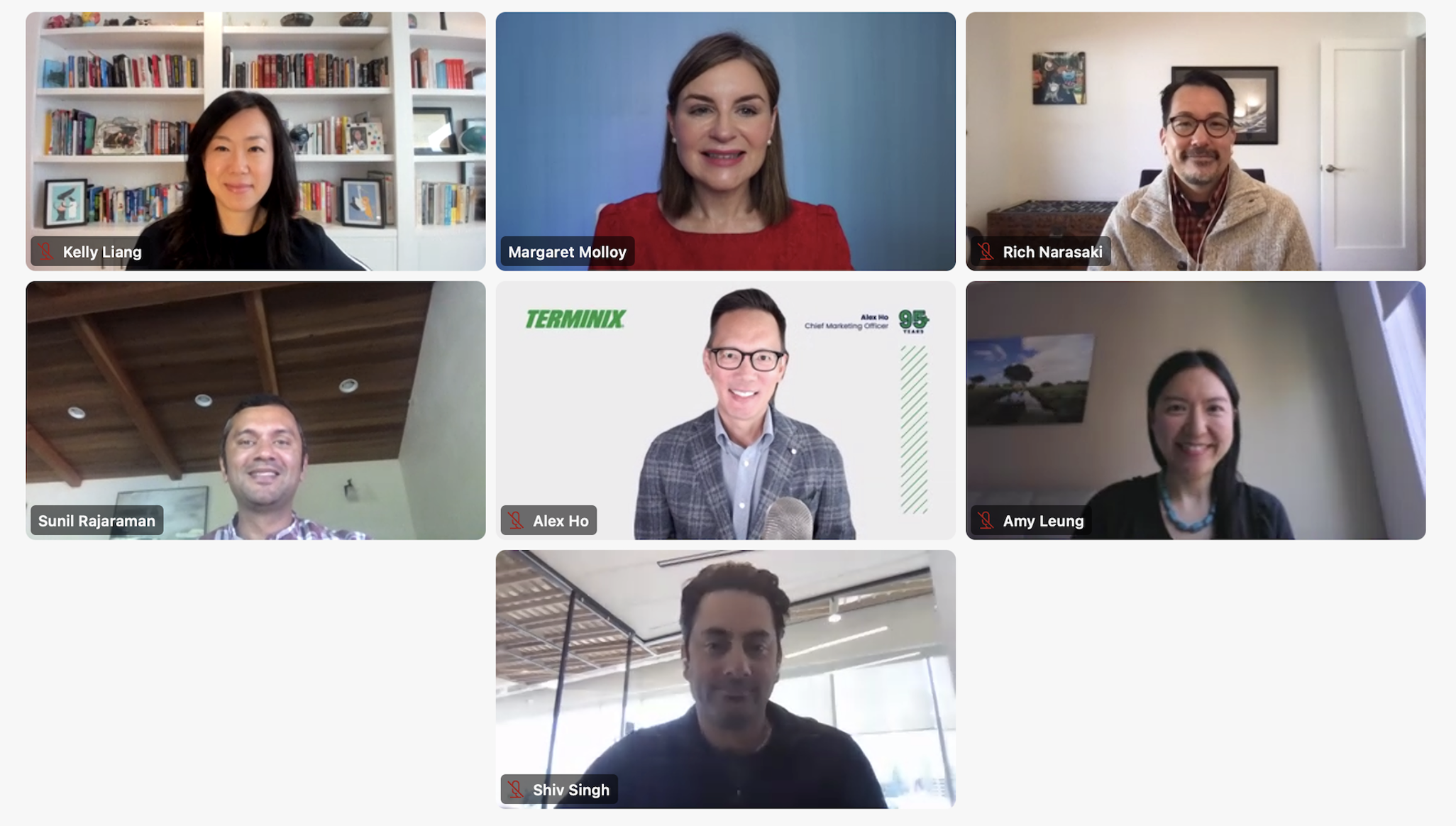As an immigrant to the United States, I’m curious about all diasporas—the origin stories, journeys, accomplishments and complex intersectional relationships with our heritage and the U.S. And as a modern brand builder, I’m equally fascinated by how brands engage authentically with people—customers, employees, partners, investors and the community. The theme of inclusive storytelling is central to both contexts.
Continuing Siegel+Gale’s Inclusive Storytelling series, we honored Asian American + Pacific Islander (AAPI) Month with a Future of Branding panel on AAPI Leadership + Inclusive Storytelling. The panel featured six marketing leaders from across industries: Carbon, Discord, LendingTree, Terminix, BNY Mellon, and GoodRx.
For context, twenty-two million Asian Americans comprise 7% of the U.S. population. Tracing their roots to more than two dozen countries, all with distinct cultures, Asian Americans and Pacific Islanders are the fastest-growing minority in the U.S. and have an expected purchasing power of $1.3 trillion by 2023.
AAPI business creation is also remarkable. In 2016, Asian-owned businesses employed more than 5 million workers in the U.S. In 2017, there were almost one million AAPI entrepreneurs across the U.S.—most of them born abroad.
While the conversation about AAPI leadership was a source of pride for the panelists, it was also profoundly human and deeply emotional. From a commercial, cultural and human lens, there was much to unpack. Together we explored the importance of dispelling the myth of the model minority, why marketers need to understand nuance and not view the AAPI community as homogenous and in light of the increase in hate crimes and racist rhetoric, why brands have an obligation not only to speak out but to take action.
In closing, I asked our panelists, “What is your commitment to inclusive storytelling, and how will you measure success?” Here are some actionable takeaways they shared:

I am very fortunate to be in a position where the commitment to diverse storytelling has started from the top; it began with our CEO and is part of our culture and mission. That makes it so much easier to get buy-in as a marketer, and that’s the first piece.
My biggest challenge is finding those stories because I operate in such a technical area. We probably lack representation in certain areas. It’s not just for APPI—it’s also Hispanic heritage, African Americans and Women’s History Month. Our industry is largely underrepresented in those areas. That’s probably the biggest obstacle we face, both internally and even among our customers. But I still realize it’s part of my job to go out there and ensure that when we do find those stories, we elevate them as much as we can. It’s all about everybody doing their part. My company can only move it so far. But collectively, when we all put an emphasis and a spotlight on it, that’s where we see the larger traction. And that’s where I’ll see the measurement of success.
—Rich Narasaki, VP, Brand Marketing, Carbon
Inclusive storytelling is a core part of Discord’s mission: to create a place of belonging for everyone. So, it’s about how we show up in three ways, the makeup of our workforce, our company culture and the communities we serve. So, in terms of our people, it’s about having an equitable and inclusive hiring process. For example, ensuring that we have a balanced candidate slate for every open role and diversity across the company at the leadership level.
On the culture side, it’s leaning on our ERGs and the programming efforts to drive employee engagement. We also developed a number of allyship and DEI training workshops to help foster that culture of inclusivity and belonging.
And on the community front, we partnered with several nonprofits and social justice organizations that align with our company values to create employing giving opportunities and volunteering opportunities.
Success is not just about hitting a set of numbers, which of course, we have goals against, but that there is an unwavering commitment and a mindset to learning and evolving that approach as we go.
—Kelly Liang, SVP, Partnerships, Discord
I think about inclusive storytelling and what we need to do on several levels. First, as we tell our brand’s story and seek to persuade consumers to take specific actions, we want to do it increasingly with richer, more inclusive stories. But the exciting challenge is to do it in a way where it doesn’t just resonate with one community but embodies deep human truths that are universally relatable. That’s incredibly difficult, but that’s very much a goal. The measures are all the usual marketing, brand building, acquisition and eventual business financial measures.
But we live in challenging times; we are in a culture war. And the latest example in the corporate world is what Disney’s dealing with in Florida. As marketing leaders, we need to keep unpacking how we can thread that needle in terms of our personal, professional and corporate responsibility to society to move the country in the right direction. And to do it in a way that takes everyone along and doesn’t create more division. That’s tough, but it’s something that we must challenge ourselves with and keep moving forward in that direction.
Lastly, I would say that it’s all about learning from each other, sharing our stories and developing a more profound sense of different perspectives. And just recognizing how much we don’t know and asking the questions.
—Shiv Singh, Chief Marketing & Customer Experience Officer, LendingTree
If your target audience happens to be AAPI—or any other segment—understanding and authenticity are key. If you’re not authentic in your marketing, you’re likely not engaging and appealing to your audience. To be authentic in marketing, you need diversity within your marketing team. It’s important to have voices in the room as you develop campaigns, insights, core product or service offerings. Structure teams so that you eliminate as many blind spots as possible. Then use the insights to ensure that you are connecting and being respectful and mindful of the community in which you’re essentially trying to persuade and ask for something.
Terminix is a business that’s conducted for people by people. So, the stories that we need to tell are every one of those small and large customer interactions. Shining a light and showcasing how our people are performing this product and generating trust and loyalty among customers is job one. And we measure that through standard feedback loops, whether it’s survey NPS or, increasingly, online reviews. If you look at a positive Google review, typically, a person says, “John N. Did this.” They name them by name. So, it’s a human-to-human, one-to-one interaction. And those are the stories that matter.
—Alex Ho, Chief Marketing Officer, Terminix
When we think of inclusive storytelling, we think about our employees, clients and communities. One of the things that attracted me to BNY Mellon was its strength in diversity pillar; 44% of new hires from 2021 were from underrepresented ethnic-racial backgrounds. As far as my commitments, I want to continue that; I want to hire diversely and insert equal representation in our advertising and marketing collateral because it matters to see other people similar to you around in marketing.
And then to actively participate in these community discussions of the ERGs and advocate for the underrepresented. Success will be measured when others look at our company. They can say that we stand for diversity and inclusion, and others can talk about the impact our inclusive storytelling has led to—that’s what all companies and brands want in the end.
—Amy Leung, Global Head of Digital & Demand Generation, BNY Mellon
GoodRx is the most mission-driven company I’ve worked for, without a doubt. And making healthcare affordable for all Americans is something that this company lives and breathes every single day, regardless of where you’re from. Our company does an outstanding job of showing the stories of different people experiencing the healthcare journey, normalizing it and making people feel like not only can they visit their provider or specialist and receive affordable medicine but bringing people back to their doctor. So many people have ignored healthcare over the past couple of years. We’re trying to focus and emphasize getting people back to interact with our healthcare system, which can help them with potential diseases or life-threatening ailments.
I grew up in demand gen, so I think of everything as being measurable in marketing. But I strongly feel that we should not measure inclusive storytelling. What I mean by that is storytelling, and inclusive storytelling is part of the day-to-day fabric of who we are.
—Sunil Rajaraman, VP Marketing, B2B, GoodRx
When we render invisible, reduce to tropes or otherwise stereotype AAPI—or any community—we rob people of their uniqueness and humanity. Conversely, connection happens when we represent people and a community accurately and expansively. Because nuance matters.
In today’s culturally polarized America, the tension for all brand leaders is to relate to people as human beings; to transcend division to tell stories that connect to universal aspirations; to unite, not alienate; and do so while achieving business goals. For brand builders, inclusive storytelling may be our generation’s strategic marketing challenge and responsibility. The ultimate endeavor is to profitably build enduring brands that reflect and shape a more inclusive society.


